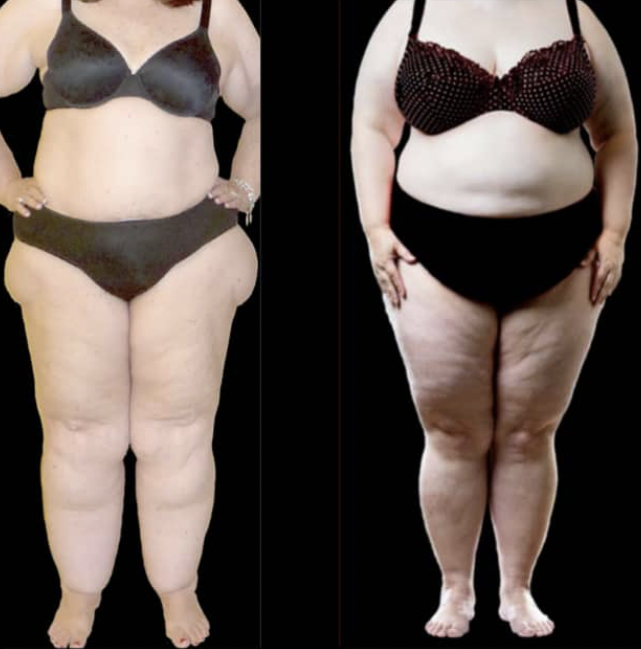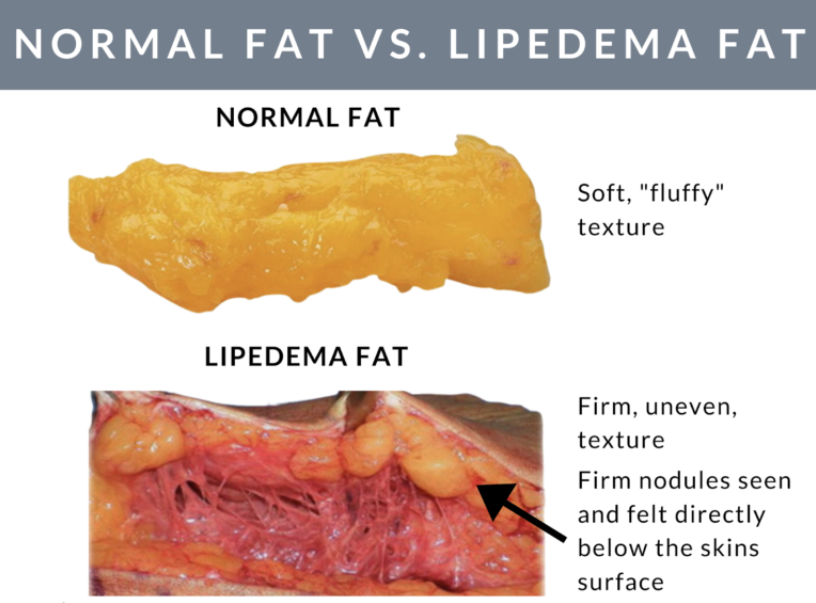In the quest for health and wellness, distinguishing between Lipedema fat and normal fat is crucial, especially for those experiencing unexplained changes in their body. Lipedema, a chronic condition characterised by the abnormal accumulation of fat, primarily affects women and is often misunderstood or misdiagnosed as obesity or Lymphedema. This blog sheds light on the key differences between Lipedema fat and normal fat, aiming to enhance understanding and recognition of this relatively common condition.
What is Lipedema Fat?
Lipedema fat is a pathological accumulation of adipose tissue, typically affecting the legs, thighs, bum and in some cases, arms. Unlike normal fat, Lipedema fat is symmetrical, painful, tender and not directly related to overall body weight or lifestyle factors like diet and exercise. This condition can lead to discomfort, pain, and mobility issues, significantly impacting quality of life.
Key Differences Between Lipedema Fat vs Normal Fat
Distribution and Symmetry:
Lipedema Fat: Symmetrically accumulates in specific areas, such as the legs, thighs, and arms, sparing the feet and hands, creating a disproportionate appearance.
Normal Fat: Distributed more evenly across the body or accumulates in common areas due to lifestyle factors, such as the abdominal region, without a specific pattern or symmetry.
Pain and Sensitivity:
Lipedema Fat: Often painful and tender to the touch. Women may experience discomfort, bruising, swelling and sensitivity in the affected areas.
Normal Fat: Typically not painful and does not exhibit the same sensitivity or bruising tendencies as Lipedema fat.
Response to Lifestyle Changes:
Lipedema Fat: Does not significantly reduce with dietary changes, weight loss, or exercise, making it particularly frustrating for those affected.
Normal Fat: Generally responsive to lifestyle changes, including a healthy diet and exercise. Weight loss efforts usually result in a reduction of fat across the body.
Texture:
Lipedema Fat: Can feel softer and more doughy or, in advanced stages, become fibrotic with a nodular texture.
Normal Fat: Maintains a consistent, smoother texture and does not become nodular.
Progression:
Lipedema Fat: May progressively worsen over time with no change in lifestyle, potentially leading to mobility issues and lymphatic dysfunction if not managed properly.
Normal Fat: Does not inherently worsen or lead to specific health conditions purely based on its presence. Although excess body fat can contribute to overall health risks, such as heart disease.
Diagnosis and Managing Lipedema
Recognising these differences is the first step towards diagnosing and managing Lipedema effectively. If you suspect you have Lipedema, seeking advice from a healthcare provider experienced in diagnosing and treating the condition is essential.
Early intervention can include manual lymphatic drainage massages (MLD), compression therapy, and in some cases, surgical options like liposuction to remove Lipedema fat, improve symptoms and halt the progression. If you’re considering Lipedema reduction surgery, check out the our patient-verified global directory of surgeons, here.
So, Lipedema Fat vs Normal Fat
Lipedema fat and normal fat are very different, with Lipedema presenting unique challenges for women that are affected. Understanding these differences is critical for proper diagnosis, treatment and management of Lipedema.
Education around Lipedema is key to improving global awareness and it’s vital to support women in navigating this often misunderstood condition. If you or someone you know is struggling with symptoms of Lipedema, encourage them to seek out a specialist who can provide them with insight and resources.
My inbox is also always open, I’ve been managing my stage 2 Lipedema for almost two years and have managed to established a routine that works for me. There is no need to struggle alone, send me an email on sophie@lipedemaandme.com.
Disclaimer: My blogs talk about Lipedema, diet, surgery and much more. I’m talking from my point of view to help women, and remind them they are not alone. I am not a medical professional, so the content above is from my own perspective with research I have done into the topic. It’s not meant as medical advice, you should always consult your doctor or a specialist for both your diagnosis, and a treatment plan.


